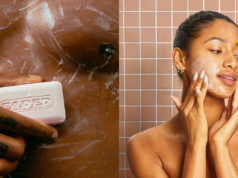If you’re someone who prefers the look and feel of smooth, hairless skin (it’s your body/hair/business!), you’re probably very aware by now of your options: Pay a bunch of money for professional treatments (like lasering, waxing, threading, etc.), ooooor master the budget-friendly route of DIY hair removal at home. The latter of which can be, uh, intimidating, to say the least.
Though there are legit *tons* of affordable at-home hair removal options, whether you’re looking to get rid of some facial fuzz or fully remove any and all body hair, it doesn’t necessarily mean you should. “Safety is a concern with at-home hair removal methods, since there may be a huge variation in user-friendly products,” says Boston-based dermatologist Uchenna Okereke, MD. Basically, every formula and device is a little bit different, so you never really know what to expect.
So to help you figure out exactly which methods and treatments are safe to try yourself, we consulted both Dr. Okereke and board-certified dermatologist Nianda Reid, MD. Ahead, the complete guide to DIY hair removal, including all the expert tips and products you’ll need to do it the right way.
According to Dr. Reid—and, tbh, myself—shaving is the quickest, cheapest, and easiest way to remove hair from a large surface area, such as the legs. Always be sure to use a shaving cream or gel to reduce irritation, and regularly switch out your razor or blade to get a closer shave (which helps reduce ingrowns). If you’re looking for a bikini line hair removal method that doesn’t involve shaving it all off, try experimenting with a trimmer instead, which will help shape your bikini line without risking ingrowns.
Shaving your face (not to be confused with dermaplaning, an exfoliating treatment that should be left in the hands of a licensed professional) is also an option for removing peach fuzz (aka vellus hairs). For the smoothest results without razor burn, you’ll need a fresh face shaver with a sharp, clean blade, a gentle cleanser, and a hydrating moisturizer.
Depilatories—aka hair-removal creams—break down the keratin proteins in your hair strand to dissolve them away. Basically, a lil chemical reaction in your follicles. Usually, you just layer them on your skin, wait for the reaction, then wipe the cream away with a wash cloth. At-home hair removal creams are probs the second easiest option after shaving (like, if you can rub a lotion on your skin, you can apply a hair-removal cream), but they’re not without a few drawbacks.
These formulas generally need to be left on the skin for 5 to 10 minutes to really work, they definitely have a chemical odor, and they can even sting a little. Dr. Reid warns that depilatory creams can cause irritation if the formula is left on the skin for too long, so make sure to actually read the directions and follow them carefully, because each formula is a little different.
If you’re considering using an at-home wax kit, you’re a braver soul than I am. Dr. Reid generally recommends sticking to smaller areas, like your upper lip or eyebrows, and unless you’re one of those people with high pain tolerance and no fear of hot wax (again, I am not), you should leave the bigger jobs/areas to a professional. With the possibility of bruising or burning yourself, attempting your own full-on Brazilian wax at home just isn’t the best idea.
To DIY smaller areas, spread the wax on your skin in the direction of hair growth, rubbing to help it adhere. If you’re using a strip wax, you’ll also need to press the strip of fabric or paper over the top of the wax. Then, grab the strip or the edge of the hard wax and quickly remove it in the opposite direction of hair growth, while holding your skin taut. Pro tip: Keep a body oil nearby to help clean off any sticky wax residue and soothe your skin afterward. You’re gonna need it.
BUT FIRST, A WARNING: If you’re currently on Accutane (or using retinoids in the area you’re planning to wax), you’re gonna want to skip this method. Seriously. These medications can make your skin extra-sensitive and thinner—i.e., a big no-no for waxing—so keep scrolling and try one of the other safer options for you.
Much like waxing, sugaring is a hair removal method that uses a sticky paste to pull the hair from the root from anywhere on the body. But unlike waxing, sugaring paste is gentler than commercial wax and doesn’t adhere to skin, which means it won’t rip off a layer of your skin, either.
If you love a challenge, whip up your own DIY sugar wax with sugar, lemon, and water, or if you’d rather get it done and over with (heard that), shop a pre-made formula instead. To use it, warm the sugar paste, spread a thin layer over the area against the grain with your fingers, then swiftly pull the strip away from your skin in the direction of the hair growth to remove it. Didn’t nail it on your first shot? Same. This method takes a lot of practice, so make sure to watch lots of tutorials to get the flicking motion just right.
If you’re working on a smaller area, like your eyebrows or upper lip, Dr. Reid says one of these DIY hair removal methods is your best bet. Whether you’re tweezing, threading, or epilating, these plucking methods work by pulling the hair out at the root, which means your skin remains intact and the area stays hair-free for longer.
The easiest method for first-timers is tweezing, but it can be painful and tedious trying to remove hair a single strand at a time. Epilating is similar to tweezing, but these devices contain tons of tiny tweezers to remove more than just one hair in a single pass. Although a ton of tiny tweezers sounds pretty brutal, the process goes much faster, so it’s less of a pain in the long run.
And then there’s eyebrow threading. This centuries-old technique uses the tension from a twisted thread to pluck the hairs and shape the brows. Although threading is one of the best options for those with sensitive skin looking to remove hair on their upper lip or their brows, the technique takes some (read: a lot of) practice, so keep a back-up pair of tweezers or epilator handy for when you get frustrated.
Although both Dr. Okereke and Dr. Reid agree that, in most cases, professional laser hair removal (a process in which a light heats up and destroys the hair follicle) is the best option for permanent hair removal, these treatments come at an (expensive) price. Packages can run into the thousands of dollars, depending on which areas of your body you’re treating and how many sessions you need. At-home lasers, on the other hand, are only a fraction of the cost and generally safe to use.
They’re not going to be as effective or as thorough as in-office treatments, but they’re better than nothing. But, says Dr. Reid, you should only use these devices as instructed on the packaging. “Darker skin tones should take precaution with at-home, light-based hair removal options,” she says, adding that if done incorrectly—or using a device not approved for deeper skin tones—”scarring and post-inflammatory pigmentation may occur, which can be permanent.”
So while at-home laser devices are an option, you can see why they’re def not foolproof. Not only that, but they’re still decently expensive compared to the other DIY hair removal methods, and they definitely aren’t an overnight fix. Last-hair removal takes months of consistent treatments to see results, so prepare yourself for the long haul. And if you do have the means to get your laser treatments done by a dermatologist, I highly recommend trying the pro route instead for faster, safer, better results.









